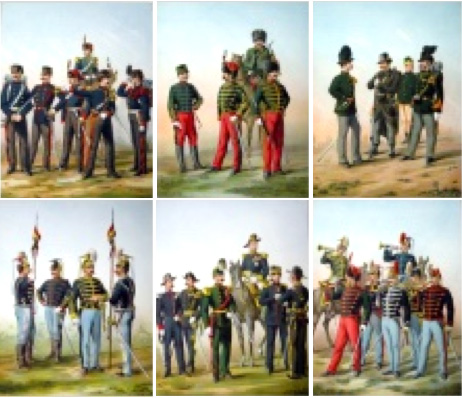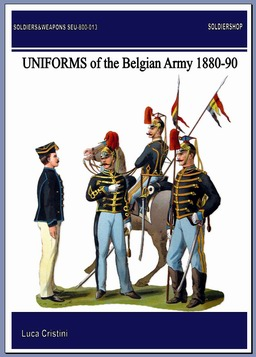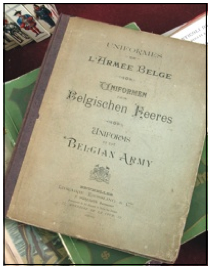*Of course there was the Boxer Rebellion and some colonial action, including the Boar War, but otherwise this period - between 1871 and 1914 - seems to be a period of preparation for The Great War!
Anyway, thus far the volumes of greatest use to me have been Haswell Miller's 'Vanished Armies' and Osprey's 'The Belgian Army in World War 1', both of which - of course - focus of the build up and early years of The Great War. However, they do include a interesting insight into the way that European armies transitioned from the Edwardian peacetime uniforms into the drabber battledress of trench warfare.
 |
| Liebig S608 Belgian Military Uniforms 1899 - these collectors cards were given away with their beef extract! Hey, I'll take reference where I can get it! Picture source: Cigcardpix Flickr album |
Well, luckily for me I happened across a slim title from the Soldiershop.com entitled 'Uniforms of the Belgian Army 1880-90'. It's more of an illustrated pamphlet than an in-depth study but it has the advantage of being an authentic period piece (re-published by the said online reference publisher).
Left: Originally published in 1893, the original pamphlet has been converted into an eBook by Soldiershop.com (Photo: Soldiershop.com)
This little book contains 12 colour lithographs featuring a total of 59 figures representing the cavalry, infantry, artillery, auxiliary and general staff of the Belgian army.
The illustrations are wonderfully quaint, but equally they are crisp and clear and give a good rendition of the colours of the various arms. Accompanying text is limited, I'm afraid, to one brief line per figure on the opposing page, giving the unit and rank of the soldier depicted. It's a great pity that this scant information has not been expanded on in some sort of supplement at the back of the re-publication, but beggars can't be choosers.
 |
| Some thumbnails of the plates showing the great diversity of uniforms which typified a pre-WW1 European army, even one as small as the Belgian. Picture source: Soldiershop.com |
That's right, this eBook didn't cost me a penny.
Now don't ask me why, for as far as I could see this PDF download should have cost me 7.50 Euros - a price, I hasten to add, that I was more than happy to pay - but perhaps due to some strange glitch at the PayPal end of Soldiershop.com's shopping cart process I could not seem to complete the transaction. Hugely disappointed I abandoned my attempt to buy the item, but on checking my email this morning I found I had been sent a link to the download for this PDF in any case!
Bizzarre! (But, hey, I'm not going to complain!)
Soldiershop.com has some additional eBooks that interest me - mainly on the French army of my target period of around 1890 - so I may be tempted to try and see if the same glitch applies. ;)
But in any case, as I said, for such a niche publication the stated price of 7.50 Euro is definitely worth the paying...IF you can pay that is.



No comments:
Post a Comment